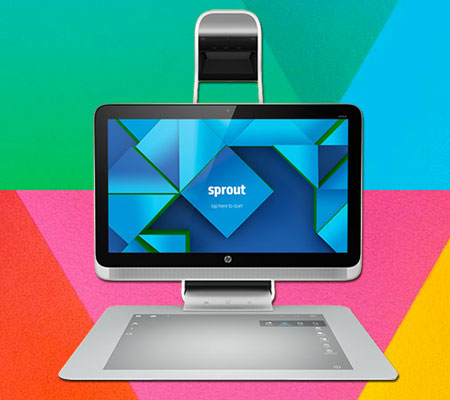HP on Wednesday announced its Blended Reality ecosystem, consisting of HP Multi Jet Fusion, an advanced 3D printer; and Sprout by HP — a combination scanner, depth sensor, high-res camera and projector that provides 3D images of items and enables real-time remote collaboration.
The ecosystem might revolutionize manufacturing, sharply reducing the design-to-prototype cycle and making it easy to customize products. It also might let individual entrepreneurs — the traditional backyard shops — carve a niche for themselves in the market.
“3D printing technologies are used in manufacturing today, but HP’s printer will be relatively low-cost and fast,” Pete Basiliere, a research vice president at Gartner, told TechNewsWorld. “That’s where the disruption will come from.”
What the Sprout’s About
The Sprout has a 23-inch, 10-point touch-enabled 1920 x 1080 pixel full HD white LED-backlit display that offers a wide viewing angle, and a horizontal 20-point capacitive touch mat.
It has an illuminator powered by a DLP projector. The illuminator’s four-camera sensory system includes an HP camera with up to 14.6-MP resolution and the Intel RealSense 3D camera for instant capture of 2D and 3D objects.
The Sprout also has a fixed 1-MP 720p HD low-light front-facing HP webcam.
It comes with the Adonit Jot Pro stylus.
The Sprout has an Nvidia GeForce GT 745A GPU, an Intel i7 CPU, and 8 GB of RAM. It uses Windows 8.1 and has 1 TB of storage.
Its HP MyRoom feature lets multiple users collaborate in real time.
Some consumer applications, including games, are already available, and HP is offering devs the Sprout SDK now.
The Sprout can be purchased from HP’s website for US$1,900, and it will be available at selected retailers later.
HP’s New 3D Printer
The HP Multi Jet Fusion Technology 3D printer is built on HP thermal inkjet technology. It includes a proprietary synchronous architecture that can image an entire area rather than just one point, improving output speed 10x, HP said.
It employs a multi-agent printing process: HP thermal inkjet arrays apply multiple liquid agents, improving accuracy and providing uniform part strength in all three axis directions. The technology includes a fusing agent applied selectively where particles fuse together, and a detailing agent applied selectively where the fusing action needs to be reduced or amplified.
“HP’s approach in attacking the speed of 3D printing, material usage and quality is fresh,” Muthuraman Ramasamy, a research manager at Frost & Sullivan, told TechNewsWorld.
HP will incorporate a full range of colors into the production process.
The company is developing a 3D platform and working with early customers in the development process.
The printer will be widely distributed in 2016.
HP’s Ecosystem Ambitions
“We see tremendous potential in the aspects of the virtual-reality handshake HP is bringing on board,” Ramasamy said. “It would help companies like GE, Boeing, BMW, and others who are pioneering the use of 3D printing for real-world applications.”
Manufacturing companies “are increasingly looking to blur the lines between the digital and the real worlds,” he continued. “This solution from HP would enable design teams to blur that boundary while effectively translating their collaborative thoughts into real-life working models and prototypes.”
However, “the industrial world is well entrenched with the AutoCADs, Siemens, PLMs and Dassaults of the world, [so] it is hard to see why they would transition from one design platform to another — like Sprout — although it offers more bells and whistles,” Ramasamy pointed out.
Custom Manufacturing Will Benefit
HP’s technology “is better for short-run manufacturing, as when you get to larger runs, even a high-speed 3D printer becomes uneconomical,” Rob Enderle, principal analyst at the Enderle Group, told TechNewsWorld.
“This will allow higher degrees of customization and let smaller shops create more interesting products, because setting up manufacturing will be less expensive,” he noted. “It will also improve rapid prototyping, which cuts across all sizes and types of physical manufacturing.”
























































That HP Sprout thing is gimmicky at best. It’s like the whole laser keyboard thing that nobody wants, where you can’t see what you’re pressing, because your hand is in front of the laser and you can’t feel which key you’re typing. It’s like the 3D film junk the industry tried to convince us we wanted and needed, but very few actually care about. If you want to be able to draw on a screen, get a Cintique or a touchscreen monitor. If you want to scan an image, use a scanner. This isn’t earth-shattering stuff or even very useful.